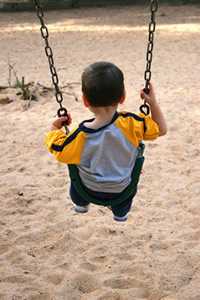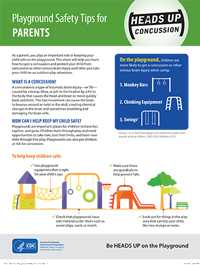Playground Safety

Each year in the United States, emergency departments (EDs) treat more than 200,000 children ages 14 and younger for playground-related injuries.1 More than 20,000 of these children are treated for a traumatic brain injury (TBI), including concussion.2 Overall, more research is needed to better understand what specific activities are putting kids at risk of injury and what changes in playground equipment and surfaces might help prevent injuries.
Occurrence and Consequences of Playground-Related Injuries
All Emergency Department-Treated, Playground-Related Injuries
- About 56% of playground-related injuries that are treated in EDs are fractures and contusions/abrasions.1
- About 75% of injuries related to playground equipment occur on public playgrounds. Most occur at a place of recreation or school.1
Playground-Related TBIs
- The overall rate of ED visits for playground-related TBI has significantly increased in recent years (2005-2013).1
- About two-thirds of playground-related TBIs occurred at school and places or recreation or sports and often involved monkey bars, climbing equipment, or swings.2
- Most ED visits for playground-related TBIs occur during weekdays, Monday through Friday.2
- Playground-related TBI ED visits occurred frequently during the months of April, May, and September.2
Deaths
Between 2001 and 2008, the Consumer Product Safety Commission investigated 40 deaths associated with playground equipment. The average age of children who died was six years old. Of these, 27 (68%) died from strangulation and six (15%) died from falls to the playground surface.1 Most strangulation involved the combination of slides or swings and jump ropes, other ropes, dog leashes or clothes drawstrings.
Injury Risk Factors
All Emergency Department-Treated, Playground-Related Injuries
- While all children who use playgrounds are at risk for injury, boys sustain ED-treated injuries (55%) slightly more often than girls (45%).3
- Children ages 5 to 9 have higher rates of ED visits for playground injuries than any other age group. Most of these injuries occur at school. On public playgrounds, more injuries occur on monkey bars and climbing equipment than on any other equipment.3
- Playgrounds that are well maintained have fewer risks to children such as rusty or broken equipment.4
Playground-Related TBIs
- Boys more often sustain playground-related TBIs compared to girls.2
- Most children who are treated for playground-related TBIs are 5 to 9 years of age.2
- Playground-related TBIs varied by age group and equipment type:
- 0-4 year olds are often injured on swings and slides.2
- 5-9 year olds are often injured on swings, monkey bars, and climbing equipment.2
- 10-14 year olds are often injured on swings, monkey bars, and climbing equipment.2
- 5 to 14 year olds sustain TBIs more frequently at school.2
What Can Be Done?
Take steps to keep kids safe by:
- Checking that playgrounds have soft material under them such as wood chips, sand, or mulch.
- Reading playground signs and using playground equipment that is right for your child’s age.
- Making sure there are guardrails in good condition to help prevent falls.
- Looking out for things in the play area that can trip your child, like tree stumps or rocks.
Related Pages
-
 Be HEADS UP on the Playground: Concussion Safety Tips for Parents
Be HEADS UP on the Playground: Concussion Safety Tips for Parents - CDC's Traumatic Brain Injury
Learn more about traumatic brain injury and concussion. - CDC's HEADS UP
Learn how to be HEADS UP to concussion.
Additional Resources
Additional playground safety tips and safety alerts can be found at the Consumer Product Safety Commission’s Playground Safety website.
References
- U.S. Consumer Product Safety Commission. Injuries and investigated deaths associated with playground equipment, 2001-2008. https://www.cpsc.gov/PageFiles/108596/playground.pdf. Published October 29, 2009. Accessed April 26, 2016.
- Cheng TA, Bell JM, Haileyesus T, Gilchrist J, Sugerman DE, Coronado VG. Nonfatal playground-related traumatic brain injuries among children, 2001-2013. Pediatrics published online: May 2, 2016 (doi: 10.1542/peds.2015-2721.R3).
- Centers for Disease Control and Prevention. Nonfatal Sports- and Recreation-Related Injuries Treated in Emergency Departments --- United States, July 2000--June 2001. MMWR 2002; 51(33):736-740.
- National Program for Playground Safety. State report cards. http://www.playgroundsafety.org/research/state-report-cards. Accessed April 26, 2016.
- Page last reviewed: May 2, 2016
- Page last updated: May 2, 2016
- Content source:
- Centers for Disease Control and Prevention,
- National Center for Injury Prevention and Control,
- Division of Unintentional Injury Prevention


 ShareCompartir
ShareCompartir